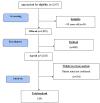Factors Influencing Participation in Clinical Trials: Emergency Medicine vs. Other Specialties
- PMID: 28874936
- PMCID: PMC5576620
- DOI: 10.5811/westjem.2017.5.33827
Factors Influencing Participation in Clinical Trials: Emergency Medicine vs. Other Specialties
Abstract
Introduction: This study investigated factors that influence emergency medicine (EM) patients' decisions to participate in clinical trials and whether the impact of these factors differs from those of other medical specialties.
Methods: A survey was distributed in EM, family medicine (FM), infectious disease (ID), and obstetrics/gynecology (OB/GYN) outpatient waiting areas. Eligibility criteria included those who were 18 years of age or older, active patients on the day of the survey, and able to complete the survey without assistance. We used the Kruskal-Wallis test and ordinal logistic regression analyses to identify differences in participants' responses.
Results: A total of 2,893 eligible subjects were approached, and we included 1,841 surveys in the final analysis. Statistically significant differences (p≤0.009) were found for eight of the ten motivating factors between EM and one or more of the other specialties. Regardless of a patient's gender, race, and education, the relationship with their doctor was more motivating to patients seen in other specialties than to EM patients (FM [odds ratio {OR}:1.752, 95% confidence interval {CI}{1.285-2.389}], ID [OR:3.281, 95% CI{2.293-4.695}], and OB/GYN [OR:2.408, 95% CI{1.741-3.330}]). EM's rankings of "how well the research was explained" and whether "the knowledge learned would benefit others" as their top two motivating factors were similar across other specialties. All nine barriers showed statistically significant differences (p≤0.008) between EM and one or more other specialties. Participants from all specialties indicated "risk of unknown side effects" as their strongest barrier. Regardless of the patients' race, "time commitment" was considered to be more of a barrier to other specialties when compared to EM (FM [OR:1.613, 95% CI{1.218-2.136}], ID [OR:1.340, 95% CI{1.006-1.784}], or OB/GYN [OR:1.901, 95% CI{1.431-2.526}]). Among the six resources assessed that help patients decide whether to participate in a clinical trial, only one scored statistically significantly different for EM (p<0.001). EM patients ranked "having all material provided in my own language" as the most helpful resource.
Conclusion: There are significant differences between EM patients and those of other specialties in the factors that influence their participation in clinical trials. Providing material in the patient's own language, explaining the study well, and elucidating how their participation might benefit others in the future may help to improve enrollment in EM-based clinical trials.
Conflict of interest statement
Conflicts of Interest: By the WestJEM article submission agreement, all authors are required to disclose all affiliations, funding sources and financial or management relationships that could be perceived as potential sources of bias. This work was funded by an unrestricted research grant from a community non-philanthropic trust:, the Anne and Carl Anderson Trust.
References
-
- Glickman SW, Anstrom KJ, Lin L, et al. Challenges in enrollment of minority, pediatric, and geriatric patients in emergency and acute care clinical research. Ann Emerg Med. 2008;51(6):775–80. - PubMed
-
- Jagsi R, Motomura AR, Amarnath S, et al. Under-representation of women in high-impact published clinical cancer research. Cancer. 2009;115(14):3293–301. - PubMed
-
- Kim ES, Menon V. Status of women in cardiovascular clinical trials. Arterioscler Thromb Vasc Biol. 2009;29(3):279–83. - PubMed
-
- Murthy VH, Krumholz HM, Gross CP. Participation in cancer clinical trials: Race-, sex-, and age-based disparities. JAMA. 2004;291(22):2720–6. - PubMed
Publication types
MeSH terms
LinkOut - more resources
Full Text Sources
Other Literature Sources
Medical
Miscellaneous

